College of Nursing: Hypoglycemia Patient Policy Manual (NSG3NCR)
VerifiedAdded on 2023/06/03
|6
|1347
|163
Practical Assignment
AI Summary
This assignment presents a comprehensive patient policy manual for the management of hypoglycemia, a condition characterized by low blood sugar levels. The manual, designed for healthcare professionals, provides detailed guidelines for managing both conscious and unconscious patients with diabetes mellitus. It outlines objectives, scope, definitions, and a policy statement emphasizing the implementation of a hypoglycemia management protocol. The procedure section details signs and symptoms, along with intervention strategies for various scenarios, including patients on insulin pumps, fluid restrictions, and specific diets. The manual also includes guidelines for managing hypoglycemia based on blood glucose levels and patient consciousness, covering treatment and follow-up management. Implementation and documentation protocols are also included, emphasizing the importance of recording patient symptoms, blood glucose levels, and treatment details. The document concludes with a call for proper disease management and diet control to manage hypoglycemia effectively, providing essential information for healthcare professionals and patients.
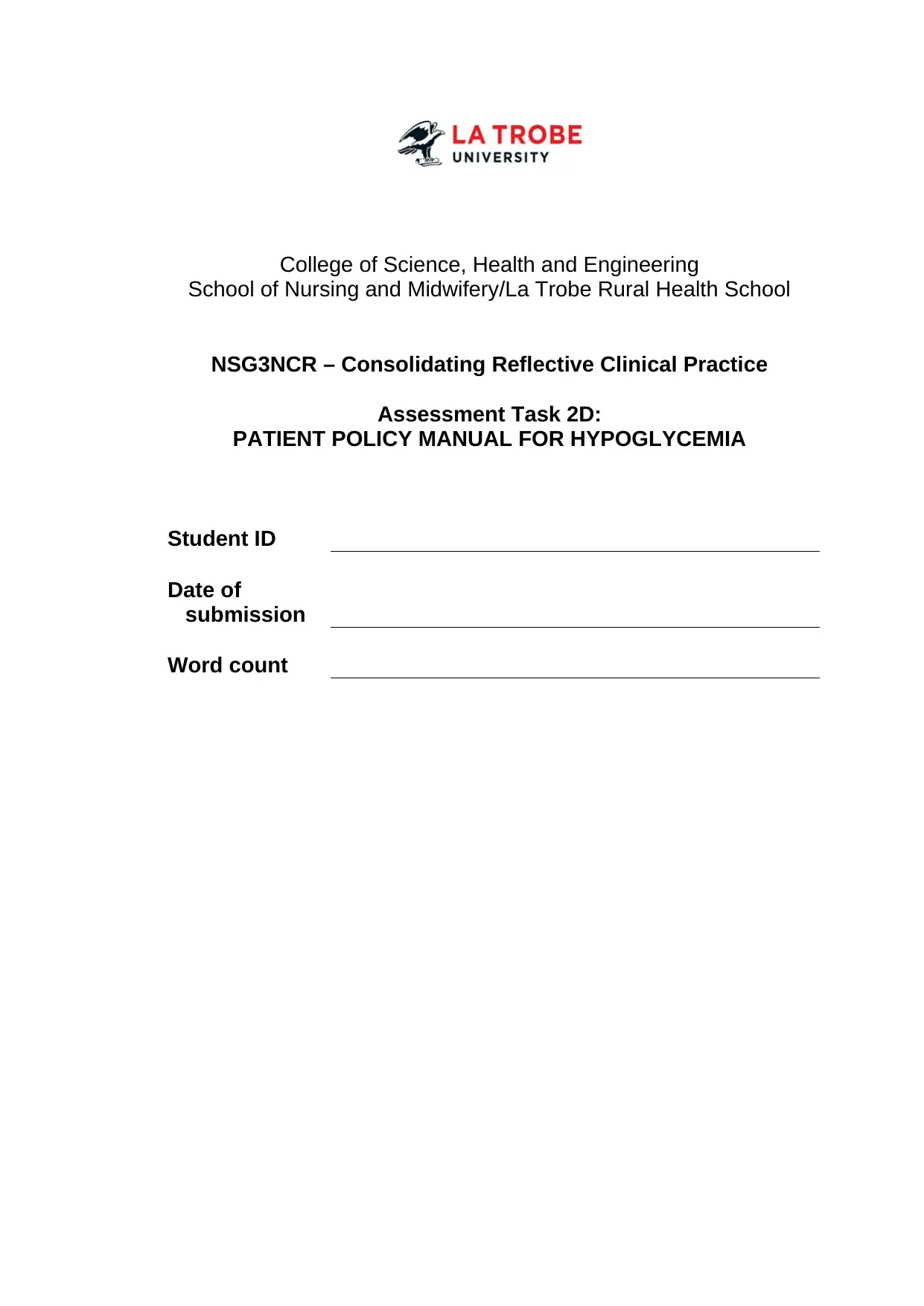
College of Science, Health and Engineering
School of Nursing and Midwifery/La Trobe Rural Health School
NSG3NCR – Consolidating Reflective Clinical Practice
Assessment Task 2D:
PATIENT POLICY MANUAL FOR HYPOGLYCEMIA
Student ID
Date of
submission
Word count
School of Nursing and Midwifery/La Trobe Rural Health School
NSG3NCR – Consolidating Reflective Clinical Practice
Assessment Task 2D:
PATIENT POLICY MANUAL FOR HYPOGLYCEMIA
Student ID
Date of
submission
Word count
Paraphrase This Document
Need a fresh take? Get an instant paraphrase of this document with our AI Paraphraser
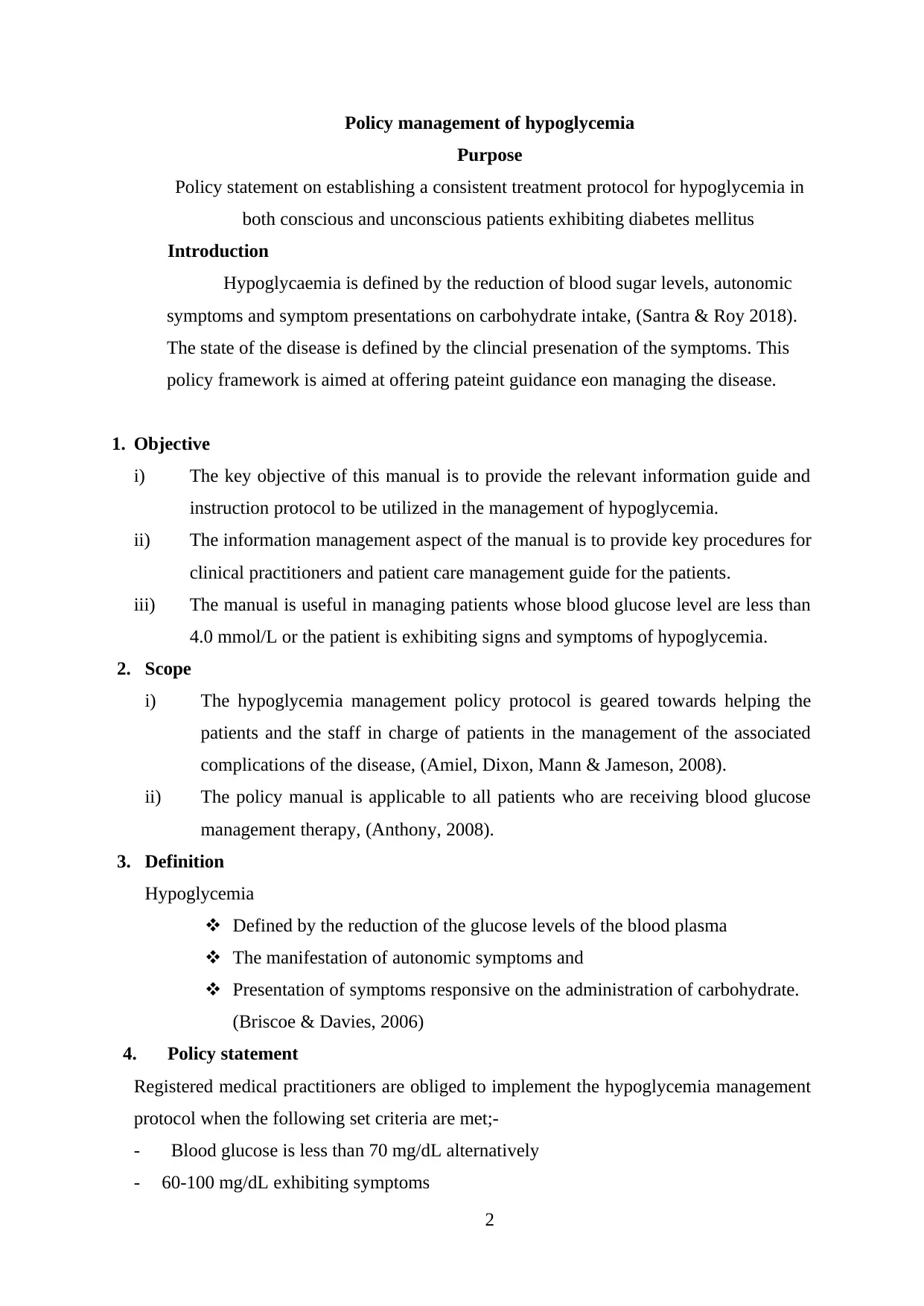
Policy management of hypoglycemia
Purpose
Policy statement on establishing a consistent treatment protocol for hypoglycemia in
both conscious and unconscious patients exhibiting diabetes mellitus
Introduction
Hypoglycaemia is defined by the reduction of blood sugar levels, autonomic
symptoms and symptom presentations on carbohydrate intake, (Santra & Roy 2018).
The state of the disease is defined by the clincial presenation of the symptoms. This
policy framework is aimed at offering pateint guidance eon managing the disease.
1. Objective
i) The key objective of this manual is to provide the relevant information guide and
instruction protocol to be utilized in the management of hypoglycemia.
ii) The information management aspect of the manual is to provide key procedures for
clinical practitioners and patient care management guide for the patients.
iii) The manual is useful in managing patients whose blood glucose level are less than
4.0 mmol/L or the patient is exhibiting signs and symptoms of hypoglycemia.
2. Scope
i) The hypoglycemia management policy protocol is geared towards helping the
patients and the staff in charge of patients in the management of the associated
complications of the disease, (Amiel, Dixon, Mann & Jameson, 2008).
ii) The policy manual is applicable to all patients who are receiving blood glucose
management therapy, (Anthony, 2008).
3. Definition
Hypoglycemia
Defined by the reduction of the glucose levels of the blood plasma
The manifestation of autonomic symptoms and
Presentation of symptoms responsive on the administration of carbohydrate.
(Briscoe & Davies, 2006)
4. Policy statement
Registered medical practitioners are obliged to implement the hypoglycemia management
protocol when the following set criteria are met;-
- Blood glucose is less than 70 mg/dL alternatively
- 60-100 mg/dL exhibiting symptoms
2
Purpose
Policy statement on establishing a consistent treatment protocol for hypoglycemia in
both conscious and unconscious patients exhibiting diabetes mellitus
Introduction
Hypoglycaemia is defined by the reduction of blood sugar levels, autonomic
symptoms and symptom presentations on carbohydrate intake, (Santra & Roy 2018).
The state of the disease is defined by the clincial presenation of the symptoms. This
policy framework is aimed at offering pateint guidance eon managing the disease.
1. Objective
i) The key objective of this manual is to provide the relevant information guide and
instruction protocol to be utilized in the management of hypoglycemia.
ii) The information management aspect of the manual is to provide key procedures for
clinical practitioners and patient care management guide for the patients.
iii) The manual is useful in managing patients whose blood glucose level are less than
4.0 mmol/L or the patient is exhibiting signs and symptoms of hypoglycemia.
2. Scope
i) The hypoglycemia management policy protocol is geared towards helping the
patients and the staff in charge of patients in the management of the associated
complications of the disease, (Amiel, Dixon, Mann & Jameson, 2008).
ii) The policy manual is applicable to all patients who are receiving blood glucose
management therapy, (Anthony, 2008).
3. Definition
Hypoglycemia
Defined by the reduction of the glucose levels of the blood plasma
The manifestation of autonomic symptoms and
Presentation of symptoms responsive on the administration of carbohydrate.
(Briscoe & Davies, 2006)
4. Policy statement
Registered medical practitioners are obliged to implement the hypoglycemia management
protocol when the following set criteria are met;-
- Blood glucose is less than 70 mg/dL alternatively
- 60-100 mg/dL exhibiting symptoms
2
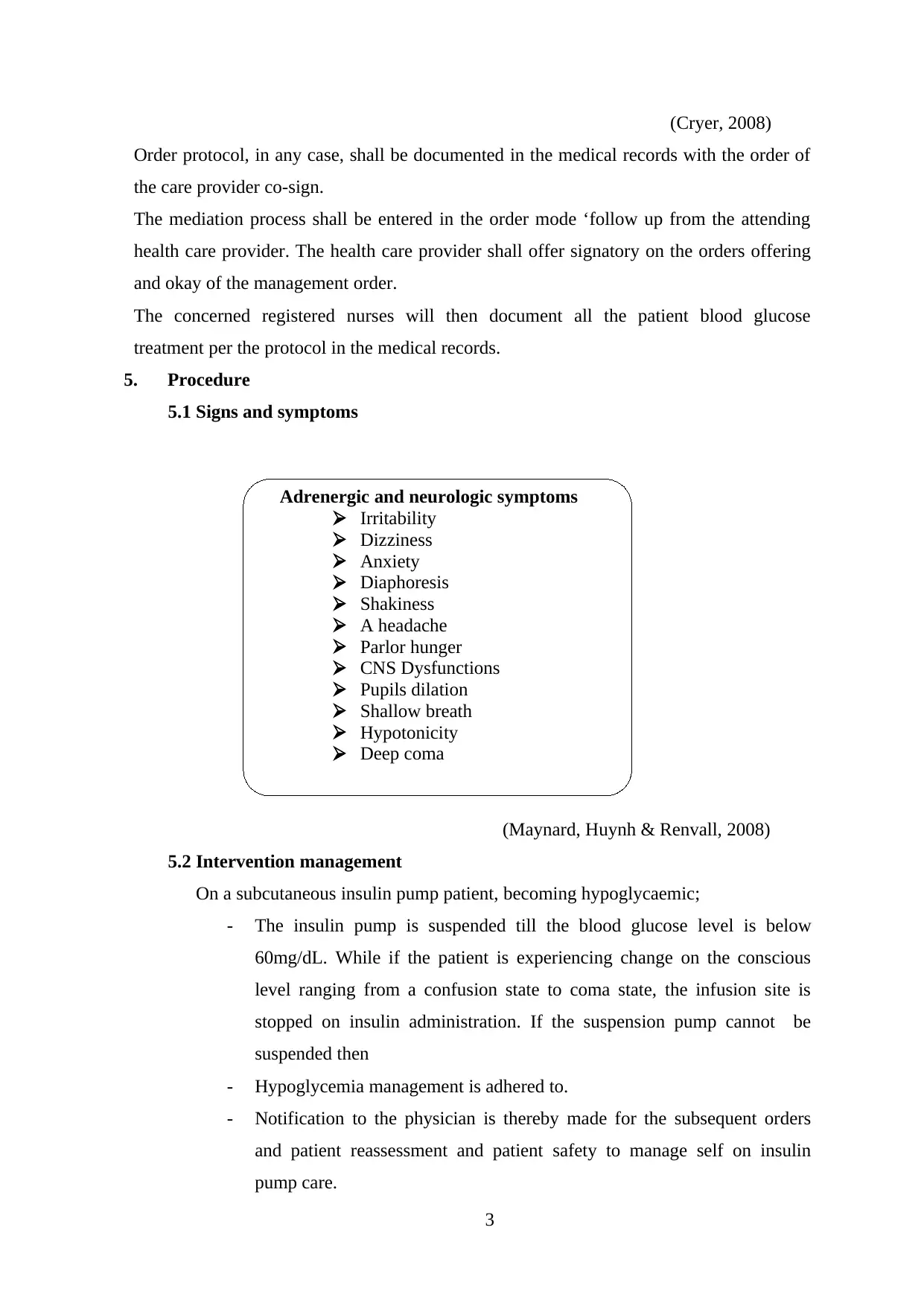
(Cryer, 2008)
Order protocol, in any case, shall be documented in the medical records with the order of
the care provider co-sign.
The mediation process shall be entered in the order mode ‘follow up from the attending
health care provider. The health care provider shall offer signatory on the orders offering
and okay of the management order.
The concerned registered nurses will then document all the patient blood glucose
treatment per the protocol in the medical records.
5. Procedure
5.1 Signs and symptoms
(Maynard, Huynh & Renvall, 2008)
5.2 Intervention management
On a subcutaneous insulin pump patient, becoming hypoglycaemic;
- The insulin pump is suspended till the blood glucose level is below
60mg/dL. While if the patient is experiencing change on the conscious
level ranging from a confusion state to coma state, the infusion site is
stopped on insulin administration. If the suspension pump cannot be
suspended then
- Hypoglycemia management is adhered to.
- Notification to the physician is thereby made for the subsequent orders
and patient reassessment and patient safety to manage self on insulin
pump care.
3
Adrenergic and neurologic symptoms
Irritability
Dizziness
Anxiety
Diaphoresis
Shakiness
A headache
Parlor hunger
CNS Dysfunctions
Pupils dilation
Shallow breath
Hypotonicity
Deep coma
Order protocol, in any case, shall be documented in the medical records with the order of
the care provider co-sign.
The mediation process shall be entered in the order mode ‘follow up from the attending
health care provider. The health care provider shall offer signatory on the orders offering
and okay of the management order.
The concerned registered nurses will then document all the patient blood glucose
treatment per the protocol in the medical records.
5. Procedure
5.1 Signs and symptoms
(Maynard, Huynh & Renvall, 2008)
5.2 Intervention management
On a subcutaneous insulin pump patient, becoming hypoglycaemic;
- The insulin pump is suspended till the blood glucose level is below
60mg/dL. While if the patient is experiencing change on the conscious
level ranging from a confusion state to coma state, the infusion site is
stopped on insulin administration. If the suspension pump cannot be
suspended then
- Hypoglycemia management is adhered to.
- Notification to the physician is thereby made for the subsequent orders
and patient reassessment and patient safety to manage self on insulin
pump care.
3
Adrenergic and neurologic symptoms
Irritability
Dizziness
Anxiety
Diaphoresis
Shakiness
A headache
Parlor hunger
CNS Dysfunctions
Pupils dilation
Shallow breath
Hypotonicity
Deep coma
⊘ This is a preview!⊘
Do you want full access?
Subscribe today to unlock all pages.

Trusted by 1+ million students worldwide
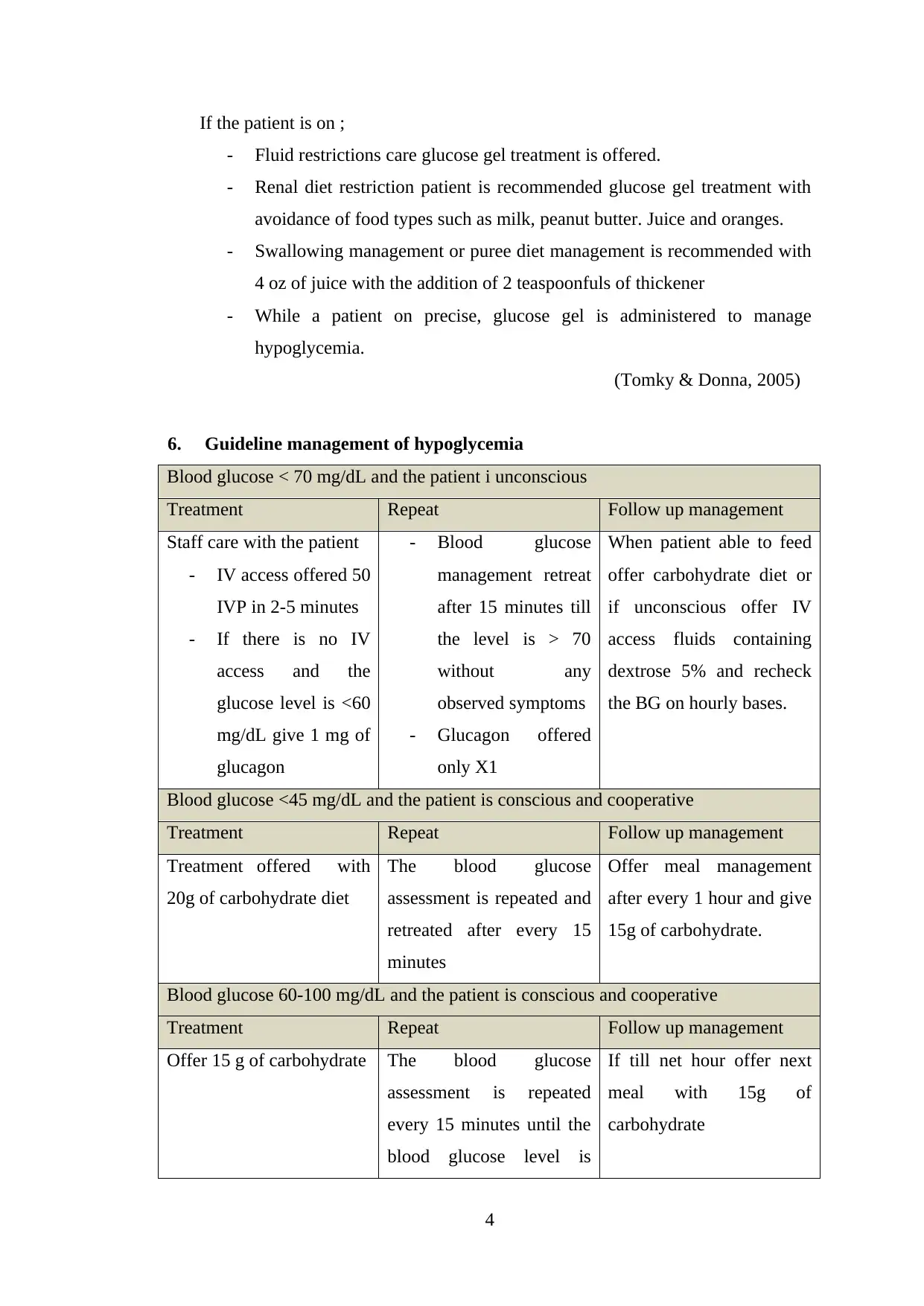
If the patient is on ;
- Fluid restrictions care glucose gel treatment is offered.
- Renal diet restriction patient is recommended glucose gel treatment with
avoidance of food types such as milk, peanut butter. Juice and oranges.
- Swallowing management or puree diet management is recommended with
4 oz of juice with the addition of 2 teaspoonfuls of thickener
- While a patient on precise, glucose gel is administered to manage
hypoglycemia.
(Tomky & Donna, 2005)
6. Guideline management of hypoglycemia
Blood glucose < 70 mg/dL and the patient i unconscious
Treatment Repeat Follow up management
Staff care with the patient
- IV access offered 50
IVP in 2-5 minutes
- If there is no IV
access and the
glucose level is <60
mg/dL give 1 mg of
glucagon
- Blood glucose
management retreat
after 15 minutes till
the level is > 70
without any
observed symptoms
- Glucagon offered
only X1
When patient able to feed
offer carbohydrate diet or
if unconscious offer IV
access fluids containing
dextrose 5% and recheck
the BG on hourly bases.
Blood glucose <45 mg/dL and the patient is conscious and cooperative
Treatment Repeat Follow up management
Treatment offered with
20g of carbohydrate diet
The blood glucose
assessment is repeated and
retreated after every 15
minutes
Offer meal management
after every 1 hour and give
15g of carbohydrate.
Blood glucose 60-100 mg/dL and the patient is conscious and cooperative
Treatment Repeat Follow up management
Offer 15 g of carbohydrate The blood glucose
assessment is repeated
every 15 minutes until the
blood glucose level is
If till net hour offer next
meal with 15g of
carbohydrate
4
- Fluid restrictions care glucose gel treatment is offered.
- Renal diet restriction patient is recommended glucose gel treatment with
avoidance of food types such as milk, peanut butter. Juice and oranges.
- Swallowing management or puree diet management is recommended with
4 oz of juice with the addition of 2 teaspoonfuls of thickener
- While a patient on precise, glucose gel is administered to manage
hypoglycemia.
(Tomky & Donna, 2005)
6. Guideline management of hypoglycemia
Blood glucose < 70 mg/dL and the patient i unconscious
Treatment Repeat Follow up management
Staff care with the patient
- IV access offered 50
IVP in 2-5 minutes
- If there is no IV
access and the
glucose level is <60
mg/dL give 1 mg of
glucagon
- Blood glucose
management retreat
after 15 minutes till
the level is > 70
without any
observed symptoms
- Glucagon offered
only X1
When patient able to feed
offer carbohydrate diet or
if unconscious offer IV
access fluids containing
dextrose 5% and recheck
the BG on hourly bases.
Blood glucose <45 mg/dL and the patient is conscious and cooperative
Treatment Repeat Follow up management
Treatment offered with
20g of carbohydrate diet
The blood glucose
assessment is repeated and
retreated after every 15
minutes
Offer meal management
after every 1 hour and give
15g of carbohydrate.
Blood glucose 60-100 mg/dL and the patient is conscious and cooperative
Treatment Repeat Follow up management
Offer 15 g of carbohydrate The blood glucose
assessment is repeated
every 15 minutes until the
blood glucose level is
If till net hour offer next
meal with 15g of
carbohydrate
4
Paraphrase This Document
Need a fresh take? Get an instant paraphrase of this document with our AI Paraphraser
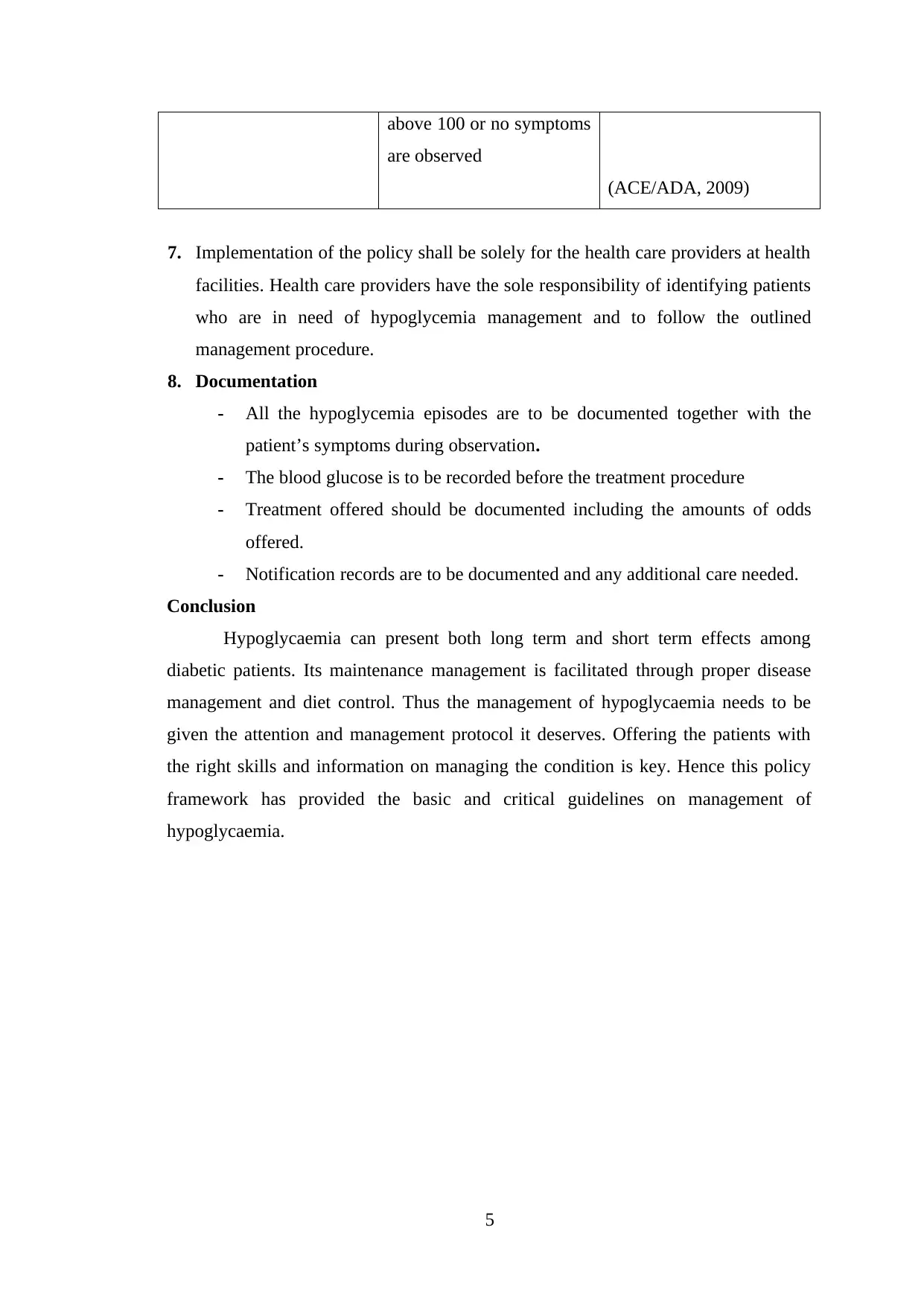
above 100 or no symptoms
are observed
(ACE/ADA, 2009)
7. Implementation of the policy shall be solely for the health care providers at health
facilities. Health care providers have the sole responsibility of identifying patients
who are in need of hypoglycemia management and to follow the outlined
management procedure.
8. Documentation
- All the hypoglycemia episodes are to be documented together with the
patient’s symptoms during observation.
- The blood glucose is to be recorded before the treatment procedure
- Treatment offered should be documented including the amounts of odds
offered.
- Notification records are to be documented and any additional care needed.
Conclusion
Hypoglycaemia can present both long term and short term effects among
diabetic patients. Its maintenance management is facilitated through proper disease
management and diet control. Thus the management of hypoglycaemia needs to be
given the attention and management protocol it deserves. Offering the patients with
the right skills and information on managing the condition is key. Hence this policy
framework has provided the basic and critical guidelines on management of
hypoglycaemia.
5
are observed
(ACE/ADA, 2009)
7. Implementation of the policy shall be solely for the health care providers at health
facilities. Health care providers have the sole responsibility of identifying patients
who are in need of hypoglycemia management and to follow the outlined
management procedure.
8. Documentation
- All the hypoglycemia episodes are to be documented together with the
patient’s symptoms during observation.
- The blood glucose is to be recorded before the treatment procedure
- Treatment offered should be documented including the amounts of odds
offered.
- Notification records are to be documented and any additional care needed.
Conclusion
Hypoglycaemia can present both long term and short term effects among
diabetic patients. Its maintenance management is facilitated through proper disease
management and diet control. Thus the management of hypoglycaemia needs to be
given the attention and management protocol it deserves. Offering the patients with
the right skills and information on managing the condition is key. Hence this policy
framework has provided the basic and critical guidelines on management of
hypoglycaemia.
5
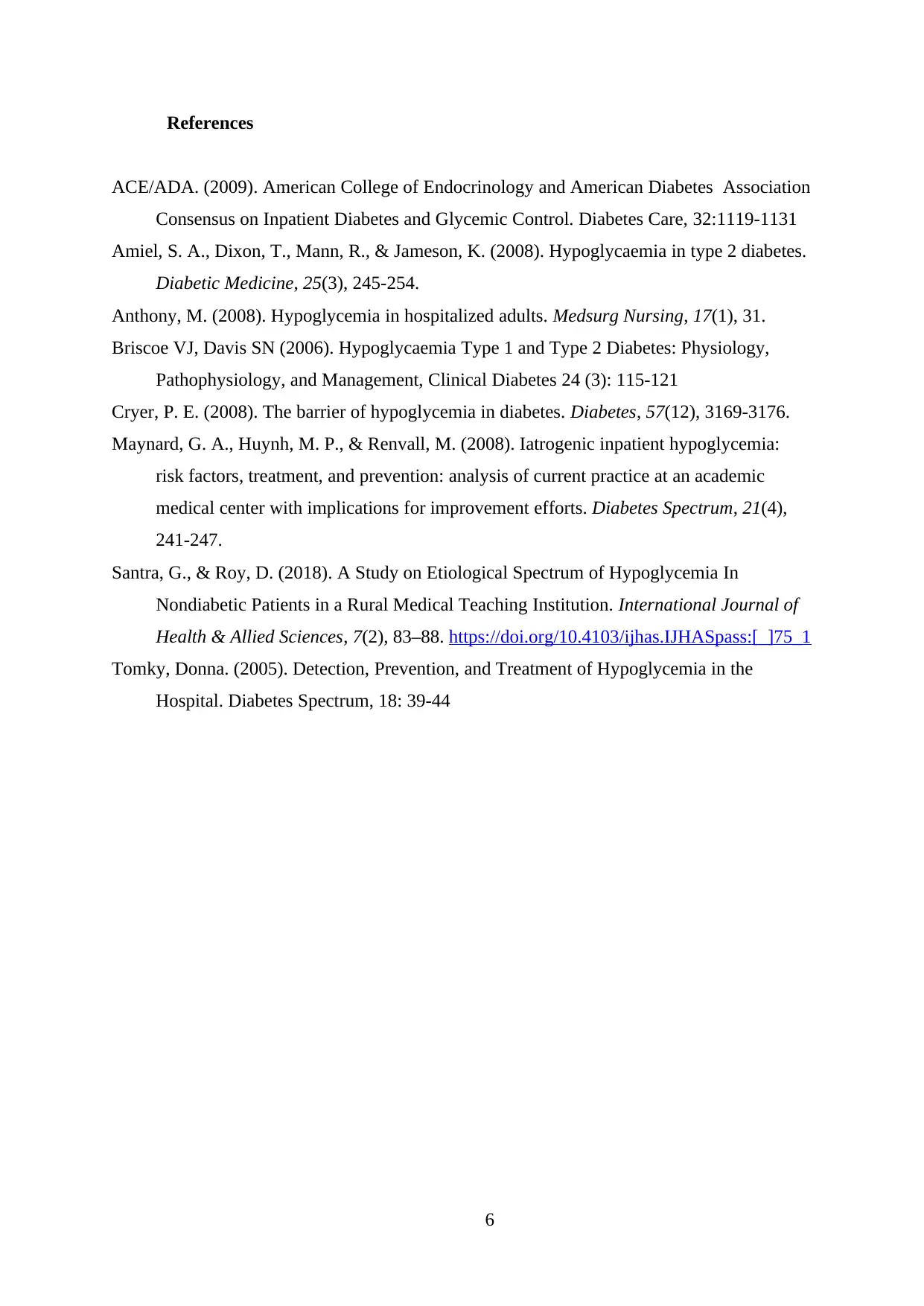
References
ACE/ADA. (2009). American College of Endocrinology and American Diabetes Association
Consensus on Inpatient Diabetes and Glycemic Control. Diabetes Care, 32:1119-1131
Amiel, S. A., Dixon, T., Mann, R., & Jameson, K. (2008). Hypoglycaemia in type 2 diabetes.
Diabetic Medicine, 25(3), 245-254.
Anthony, M. (2008). Hypoglycemia in hospitalized adults. Medsurg Nursing, 17(1), 31.
Briscoe VJ, Davis SN (2006). Hypoglycaemia Type 1 and Type 2 Diabetes: Physiology,
Pathophysiology, and Management, Clinical Diabetes 24 (3): 115-121
Cryer, P. E. (2008). The barrier of hypoglycemia in diabetes. Diabetes, 57(12), 3169-3176.
Maynard, G. A., Huynh, M. P., & Renvall, M. (2008). Iatrogenic inpatient hypoglycemia:
risk factors, treatment, and prevention: analysis of current practice at an academic
medical center with implications for improvement efforts. Diabetes Spectrum, 21(4),
241-247.
Santra, G., & Roy, D. (2018). A Study on Etiological Spectrum of Hypoglycemia In
Nondiabetic Patients in a Rural Medical Teaching Institution. International Journal of
Health & Allied Sciences, 7(2), 83–88. https://doi.org/10.4103/ijhas.IJHASpass:[_]75_1
Tomky, Donna. (2005). Detection, Prevention, and Treatment of Hypoglycemia in the
Hospital. Diabetes Spectrum, 18: 39-44
6
ACE/ADA. (2009). American College of Endocrinology and American Diabetes Association
Consensus on Inpatient Diabetes and Glycemic Control. Diabetes Care, 32:1119-1131
Amiel, S. A., Dixon, T., Mann, R., & Jameson, K. (2008). Hypoglycaemia in type 2 diabetes.
Diabetic Medicine, 25(3), 245-254.
Anthony, M. (2008). Hypoglycemia in hospitalized adults. Medsurg Nursing, 17(1), 31.
Briscoe VJ, Davis SN (2006). Hypoglycaemia Type 1 and Type 2 Diabetes: Physiology,
Pathophysiology, and Management, Clinical Diabetes 24 (3): 115-121
Cryer, P. E. (2008). The barrier of hypoglycemia in diabetes. Diabetes, 57(12), 3169-3176.
Maynard, G. A., Huynh, M. P., & Renvall, M. (2008). Iatrogenic inpatient hypoglycemia:
risk factors, treatment, and prevention: analysis of current practice at an academic
medical center with implications for improvement efforts. Diabetes Spectrum, 21(4),
241-247.
Santra, G., & Roy, D. (2018). A Study on Etiological Spectrum of Hypoglycemia In
Nondiabetic Patients in a Rural Medical Teaching Institution. International Journal of
Health & Allied Sciences, 7(2), 83–88. https://doi.org/10.4103/ijhas.IJHASpass:[_]75_1
Tomky, Donna. (2005). Detection, Prevention, and Treatment of Hypoglycemia in the
Hospital. Diabetes Spectrum, 18: 39-44
6
⊘ This is a preview!⊘
Do you want full access?
Subscribe today to unlock all pages.

Trusted by 1+ million students worldwide
1 out of 6
Related Documents
Your All-in-One AI-Powered Toolkit for Academic Success.
+13062052269
info@desklib.com
Available 24*7 on WhatsApp / Email
![[object Object]](/_next/static/media/star-bottom.7253800d.svg)
Unlock your academic potential
Copyright © 2020–2025 A2Z Services. All Rights Reserved. Developed and managed by ZUCOL.




